Where have our buttock muscles gone?
I know we have discussed the butt muscles or ‘glutes’ before, but it never ceases to amaze me how lazy our buttocks can be. I see many injuries day to day and nearly all of those of the leg can be traced back to weakness of the derriere.
I often ponder, what makes our buttocks just switch off? Can we blame our sedentary lifestyle? Can all those years at school, university or behind the desk at work be the cause? Surely our young children are born with and have a lovely active buttock, so what happens? I even think about whether our more active forefathers had lazy rear ends? Note the image below. Notice the perky and full buttocks before our time on Earth and the not so shapely rear of our fellow on the end. My goodness, that posture generally! I can barely look.
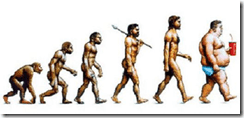
So, what is it that makes the buttocks muscles so critical for good performance of our back, hip and leg? And what happens when we have a comatose rear?
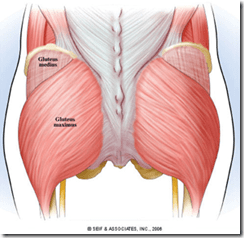
What is the importance of the buttock muscles?
The buttocks or gluteals have several important roles.
Firstly, they are the power house muscle of the legs (along with quads/thighs). You need these to get your power on push off on every step. This includes as you walk, run, take the stairs and get up out of your chair. They are also massive shock absorbers of your body’s impact every time your foot hits the ground (in other words known as eccentric or deceleration loading).
Secondly, theyare important stabilisers of the leg bone (femur) in the pelvis, stopping the sideways shift and drop of the pelvis every time you hit the ground. This is critical for good stability and safety of the region, including about the back.
This in all creates and ensures a great balance and efficiency of the work of all muscles about the area. Greater efficiency of your movement means more strength and endurance. This in turn equates to less injury risk of the back, hip and leg. And we all would like that.
What is the importance of the buttock for the hip region?
We need a good balance of muscles in any region of the body. This is the way in which muscles work together for good coordination of movement, control and stability. If there is not this balance or control, then there will be compensations or changes present. Some muscles will not work hard enough (the ‘under-actives’) and others will step up to work harder (the ‘over-actives’).
‘Under-activity’ or laziness of any muscle is important as this will result in your clever brain making allowances and it will do all in its power to adapt and have you still able to move. What could these adaptations be for a weak butt?
The brain can ‘rewire’ itself to activate any muscle about the joint that can chip in and do the work of the lazy butt – this can include any or all of the following muscles:
- Deep hip rotators ( ‘butt clenching’ tendencies)
- Hip flexors at the front of your hip
- Hamstrings (the long and big muscles that run from your buttock to behind the knee. Ever wondered why one is always tighter than the other, or why you find it increasingly hard to sit with your legs out in front of you on the floor or bed?
- ITB – the big muscle and its band that cross form your hip to the outer knee
- Large back muscles (‘back clenching’ tendencies)
‘Over-activity’ of these muscles will cause changes in the physics of the region, from altered movement to muscle engagement and joint alignment. This can include:
- Irritation and spasm of the lower back and pelvic joints
- Hamstring niggles and tears
- ITB syndrome
- Knee pain due to patella tracking problems
- Achilles tendon aches and tendonitis – recent research links weak gluts to Achilles tendon over-loading problems (Medicine and Science in Sports and Exercise).
Does any of this sound familiar?
The self test of weak buttocks. The step down test.
It’s really easy to see if you have weak or lazy buttocks. Perhaps you already have a hunch as you have back and hip pain, or really tight hamstrings running down the back of your leg.
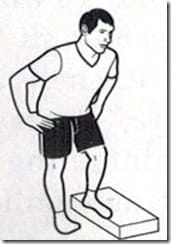
Simply stand on a step and slowly step down to tap your heel to the ground. Come back up. Repeat 10 times slowly in front of a full mirror.
- Does your pelvis drop down on one side instead of staying level?
- Does your pelvis shift out a lot further laterally on one side?
- Does your trunk shift and twist with the effort or can it stay tall and upright?
- How does the control about your knee look? Does it wobble side to side or roll inwards excessively?
- Is there an obvious difference left to right?
Answering yes to any of these shows a laziness or weakness in the glut. Perhaps it is there but not activating as your brain is choosing to ignore it over use of other muscles such as hamstrings.
OK, I’m weak, but how do I fix this now?
Why not make these a part of your warm up at the gym or spend 5 minutes in front of the telly at night? Just aim for 2 or 3 times a week, and be aware of good form. Slow down – slow controlled movements will really make all the difference.
Theraband squatting and side stepping
What for?
Gluteus maximus and medius strengthening – an all over buttock challenge
How?
Standing with your feet hip width apart and theraband looped around your knees, find your ‘neutral pelvis’ posture. Fold your trunk over your hips as if you were aiming to sit onto a chair, your knees bending and your weight shifting into your heels. Remember your tall waist posture and unchanging spinal curves. As you push up to a standing posture, push through your heels and be aware of your buttock muscles activating.
You can make this more challenging with sidestepping squats across the room. Remember your sinking hips, folding trunk, tall waists and pushing up through your heels. When sidestepping, feel your leading leg doing most of the work.
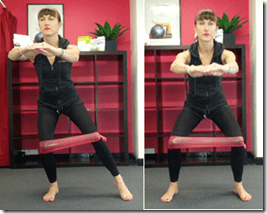
How many?
Squat or side step continuously for 60 seconds. Do this 3 times with 60 seconds recovery between sets.
Clam with theraband
What for?
Pelvic control and gluteus medius endurance
How?
Lie on your side with the theraband looped about the knees. Become aware of your pelvis position with ‘neutral pelvis’ zone and hips stacked on top of each other. Have your knees bent comfortably in front of you. Keeping your feet together, slowly raise your knee over a count of 3 and lower again over a count of 3. This is one rep.
![clip_image002[4] clip_image002[4]](/blog/image.axd?picture=clip_image002%5B4%5D_thumb.jpg)
How many?
Continue continuously for 60 seconds, 3 times with a 60 second recovery between sets.
Try to keep the pelvis controlled and hips always stacked. Make the leg heavy as if you were imagining dragging it through honey.
Step downs
What for?
Gluteus maximus and medius control and absorbing load or impact, such as is needed for walking and running
How?
Stand ona step with your left foot near the edge and right foot off the step. Become aware of your ‘pelvis neutral’ position and level hips. Lower your right leg to tap your heel to the ground. Return to the starting position for the first rep. Ensure that your knee does not pass the line of your toes on the left foot and keep your knee centred over the midline of your foot. Keep a close eye on your hip level, not allowing any drop side to side.
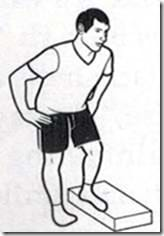
How many?
Continue slow and steady for 60 seconds, alternating 2 times on each leg.
Enjoyed this post? Here's another from 2013 where I demonstrate my top 3 exercises for gluteal amnesia
So go forth, find your buttocks and your inner cave man with The Fix Program Online!
Join an online class from the comfort of your home - Katrina the principle physio at The Fix Program has designed a series of Pilates exercise programs that will help you immensely.